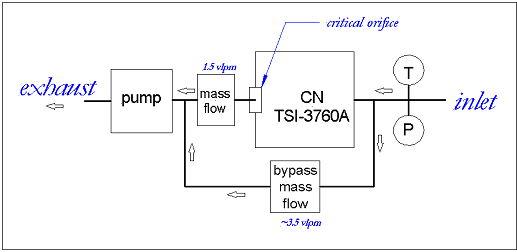By Dave Rogers, 12-7-07
See also emails with Cindy Twohy: folder PMS-cal, subject "CN and PCASP flow" March 2001
Correction equations for CN and UHSAS measurements
RAF operates several different types of aerosol instruments. For all of these, and for all other particle measurements, the concentrations are calculated for ambient air density so that they can be combined or compared readily.
Butanol CN instruments (TSI-3010, TSI-3760, TSI-3760a, TSI-3025a)
The "standard" RAF CN measurement is using TSI-3760a. It has a critical orifice at the outlet that controls the volume flow at nominal 1.5 vlpm. RAF added a Sierra mass flow sensor just downstream to measure the flow. RAF also added T, P sensors at the inlet of the CN counter.

The TSI-3760a data output includes logic pulses (one for each particle) and serial RS‑232. As of fall 2007, RAF monitors only the particle count, CNTS, and does not collect any of the RS-232 data.
The concentration of CN is calculated in nimbus (cnctr.c) as particle counts divided by volume of sample air (function sconcn),
concn = cnts * DIV / (fcnc * 1000.0 / 60.0);
Three corrections are needed to the measured concentration. #1 and #2 are in cnctr.c:
(1) convert mass flow to volume flow (function scFlow)
flowc = flow * (1013.25 / pressure) * ((temperature + Kelvin) / 294.26);
where "flow" is the mass flow rate (slpm), "pressure" is PCN, "temperature" is CNTEMP, and 294.26K is the manufacturer-s reference temperature for the Sierra mass flow meter.
(2) coincidence. At high concentrations (> ~10,000 /cc), there may be more than one particle in the laser beam, and the coincidence error can be ~10%. The correction method is prescribed by the manufacturer and is done in function sconcn
The TSI-3025a instrument is different, in that the aerosol sample flow is 10% of the total and is injected into a particle-free sheath flow (90%). Hence the sample is diluted sufficiently that coincidence is unlikely to occur unless concentrations > 100,000 /cc.
(3) adjust concentration to ambient air density (what function does this?)
concn = concn * (PSXC/PCN) * (CNTEMP + 273.15)/(ATX + 273.15)
The magnitude of this adjustment depends on the type of inlet (forward or aft-facing). For ICE-L flight RF04, it is a factor ~1.1 to 1.2.
Note there is a fourth possible correction that exists because the air becomes saturated with butanol vapor at ~17°C as it passes through the CN counter. Hence it-s no longer just air. This will affect the mass flow measurement and the correction to ambient air density. The affect is probably minor, since the vapor pressure is only ~4.5 mb.
Water-based CN instruments, WCN (Quant WCPC-LP), serial RS-232 data.
RAF has two of these instruments. WCN is similar to the TSI-3025a in that it has separate sheath can sample flows. Both flows are volume-controlled by internal pumps. Both flows are very stable at 300 vccm (0.3 vlpm) throughout the altitude range of HIAPER.
All data comes through RS‑232 serial feed at 10 sps. Values include the same basic parameters that come from the butanol instrument systems (counts, sample flow, sheath flow, P, T) plus housekeeping. The instrument also calculates and outputs the CN concentration. Therefore, RAF has two options for processing the WCN data: (a) nimbus calculation of CONCN in the same way as the butanol CN, and (b) use CONCN from the serial data stream. Both methods should yield the same result, which is a useful check.
If method (a) is used, then the flow must be converted from vlpm to slpm before sending to function scFlow, which converts it back to vlpm. If method (b) is used, however, then only the correction to ambient air density is required:
concn = concn * (PSXC/PCN_WCN) * (TOCN_WCN + 273.15)/(ATX + 273.15)
WCN was flown in ProgSci, T-REX and PACDEX. The typical ambient correction factor is ~1.1 to 1.5.
UHSAS, (Particle Metrics, Inc.), serial RS-232 data stream
RAF has one UHSAS. It measures the concentration of particles 0.075 to 1000 µm diameter in 99 bins. It has both sample and sheath flows that use internal Alicat volume flow controllers. However, the values that are reported in RS‑232 data are sccm, not vccm. Therefore, they should be converted in nimbus to volume for calculating concentrations. Nominal setpoint values: sample flow ~45 sccm, sheath flow ~600 sccm. Reference temperature for the Alicat controller is 25°C (different than for the butanol CN Sierra controller). Therefore,
flowc = flow * (1013.25 / PSXC) * ((ATX + 273.15) / 298.15);